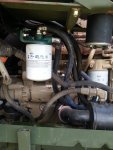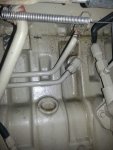- 268
- 483
- 63
- Location
- Indianapolis, Indiana
The subject of this post is my 1990 M923A2 with the Cummins 6CTA 8.3 engine. It was a 2009 "rebuild" at Kansas, including a tag on the front of the engine that says it has standard bore liners and standard size main / rod journals. When I bought the truck from GL in the fall of 2013, it had the standard green coolant in it, and it had a leaky / cracked radiator cap that it took me a while to find, so it got topped off a few times with 50/50 mix of Prestone green coolant. It always tested at -40F, so I left it in there. I was still doing the RV conversion so it did not get driven on the road for almost 2 years.
Fast forward to September of 2015 when I decided to install a block heater and found out how dirty that the cooling system really was. It had seriously brown coolant at the bottom of the radiator, and stayed brown for the first couple of flushes due to sediment in the radiator end tanks. I kept flushing it until I got clean water out the bottom, performing multiple heat up / cool down cycles to make sure coolant got moving through the radiator to clean it out. Not wanting to deal with coolant additives, and taking the advice of the guy at Napa, I selected the Zerex G05 heavy duty coolant, which is supposed to be a hybrid organic acid type (OAT) coolant that requires no additives. It has a Cummins spec listed on it saying it is approved, so I thought it was a good choice. While I had the system open, I added a coolant filter in parallel to the heater core as well.
In the fall of 2016, I started to notice coolant coming down the driver's side of the engine. I thought it was probably a result of one of the hose clamps being loose, so I went around and tightened every one of them, and most were somewhat loose. I confirmed when I started driving the truck this year that the coolant hadn't stopped coming down the side of the block though. After running out of other things to check, since the origin of the leak appeared to be from the head gasket joint, I decided to bite the bullet and put in a new head gasket. That's consumed every free minute I've had for the last week, but the truck is running again now, hopefully leak free. We'll see. When I drained the coolant this time, it was all the original color, but the coolant filter had probably a teaspoon of rusty brown grit in it when I cut it open. I flushed the engine once with hose water and once with distilled water before refilling it with the green stuff.
What I can confirm for you is that the head gasket used in my engine was the older Fel-Pro "Printo-seal" technology of a silicone sealing bead printed onto a metal carrier. OAT style coolants are known to attack silicone seals when they are not properly silicated. I found several spots near where I saw the coolant leak that this sealing bead had delaminated from the carrier and could have been the source of my leak. You can get a replacement of that same style of gasket from any number of places online, but I opted to go with the Cummins replacement part, which is a Dana "Victocor" style of gasket, with metal fire rings, Viton seals for oil passages, and a graphite carrier that seals the cooling passages. Yes it cost more, but it's a superior technology in my opinion. I know there isn't any silicone in the head gasket to fail in the future, but I still went back with green coolant and an SCA additive package, just in case there is another place in the engine that the OAT type coolant can cause pain for me.
I know this is a long post, but I wanted to put this information out there in the hopes of keeping anyone else from having to do this same job. I can't prove 100% that the OAT coolant caused my problems, but I have strong suspicions. It wasn't a hard repair per se, but it did take a lot of time and energy and required some creativity since I was doing it in my driveway without access to a crane or sufficient engine hoist.
From 2015 coolant flush:

From 2017 head gasket replacement:







Others have discussed this on steelsoldiers in the past (but on different vehicles), so I am attaching some additional reading below. Your experiences and opinions may vary.
https://www.steelsoldiers.com/showthread.php?70843-Zerex-ELC-Coolant
https://www.steelsoldiers.com/showt...rite-type-or-just-green-heavy-duty-type/page2
Fast forward to September of 2015 when I decided to install a block heater and found out how dirty that the cooling system really was. It had seriously brown coolant at the bottom of the radiator, and stayed brown for the first couple of flushes due to sediment in the radiator end tanks. I kept flushing it until I got clean water out the bottom, performing multiple heat up / cool down cycles to make sure coolant got moving through the radiator to clean it out. Not wanting to deal with coolant additives, and taking the advice of the guy at Napa, I selected the Zerex G05 heavy duty coolant, which is supposed to be a hybrid organic acid type (OAT) coolant that requires no additives. It has a Cummins spec listed on it saying it is approved, so I thought it was a good choice. While I had the system open, I added a coolant filter in parallel to the heater core as well.
In the fall of 2016, I started to notice coolant coming down the driver's side of the engine. I thought it was probably a result of one of the hose clamps being loose, so I went around and tightened every one of them, and most were somewhat loose. I confirmed when I started driving the truck this year that the coolant hadn't stopped coming down the side of the block though. After running out of other things to check, since the origin of the leak appeared to be from the head gasket joint, I decided to bite the bullet and put in a new head gasket. That's consumed every free minute I've had for the last week, but the truck is running again now, hopefully leak free. We'll see. When I drained the coolant this time, it was all the original color, but the coolant filter had probably a teaspoon of rusty brown grit in it when I cut it open. I flushed the engine once with hose water and once with distilled water before refilling it with the green stuff.
What I can confirm for you is that the head gasket used in my engine was the older Fel-Pro "Printo-seal" technology of a silicone sealing bead printed onto a metal carrier. OAT style coolants are known to attack silicone seals when they are not properly silicated. I found several spots near where I saw the coolant leak that this sealing bead had delaminated from the carrier and could have been the source of my leak. You can get a replacement of that same style of gasket from any number of places online, but I opted to go with the Cummins replacement part, which is a Dana "Victocor" style of gasket, with metal fire rings, Viton seals for oil passages, and a graphite carrier that seals the cooling passages. Yes it cost more, but it's a superior technology in my opinion. I know there isn't any silicone in the head gasket to fail in the future, but I still went back with green coolant and an SCA additive package, just in case there is another place in the engine that the OAT type coolant can cause pain for me.
I know this is a long post, but I wanted to put this information out there in the hopes of keeping anyone else from having to do this same job. I can't prove 100% that the OAT coolant caused my problems, but I have strong suspicions. It wasn't a hard repair per se, but it did take a lot of time and energy and required some creativity since I was doing it in my driveway without access to a crane or sufficient engine hoist.
From 2015 coolant flush:


From 2017 head gasket replacement:








Others have discussed this on steelsoldiers in the past (but on different vehicles), so I am attaching some additional reading below. Your experiences and opinions may vary.
https://www.steelsoldiers.com/showthread.php?70843-Zerex-ELC-Coolant
https://www.steelsoldiers.com/showt...rite-type-or-just-green-heavy-duty-type/page2
Last edited:


